
PREV ARTICLE
NEXT ARTICLE
FULL ISSUE
PREV FULL ISSUE
NUMISMATOURIST HOWARD BERLIN VISITS MADRID
Globetrotter Howard Berlin, better known in the hobby as The Numismatourist, traveled to Madrid, Spain recently, and he filed this report
for E-Sylum readers. Thanks! -Editor
This trip was a bit different most of my previous ones – my wife would be joining me and we would be celebrating our 40th wedding anniversary at the trip’s end. Our trip would cover Madrid plus a number of cities down to the Costa del Sol and Gibraltar, and then a few days in London to include a day trip to Oxford. Our first stop was Madrid, a city I had been to several times. Besides, tapas and other culinary specialties, it has three numismatic venues, which for various reasons, I was not able to visit two of them on my previous visits – only seeing the buildings from the street. This time would be different, making appointments with the museums. 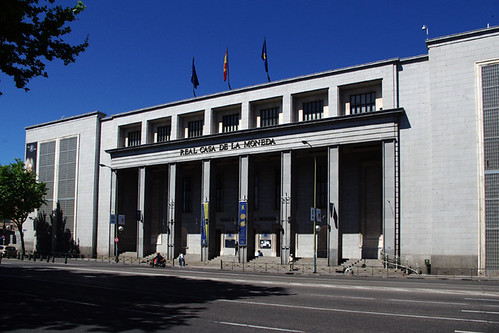
Street view of Madrid’s Royal Mint. 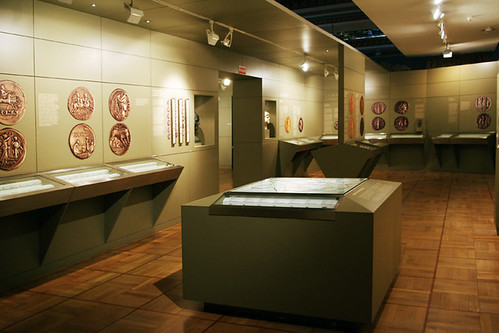
Partial view of one of the many mint museum’s many galleries. Early Saturday morning we went to see the museum at Spain’s Royal Mint, Real Casa de Moneda. I had written Juan V. Teodoro Vidal, the museum’s director several weeks before and he was able to clear the way for my visit and allow me to take photographs. We were directed to the third floor where the permanent exhibit was located in more than 17 rooms, or halls. My only complaint to what was otherwise an excellent exhibition in its breath and scope, was that the explanatory text is only in Spanish (yo no hablo español). 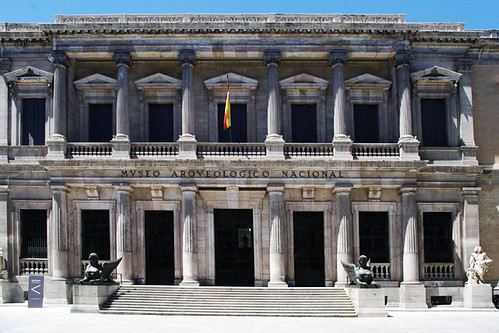
Front facade of the National Archeological Museum. 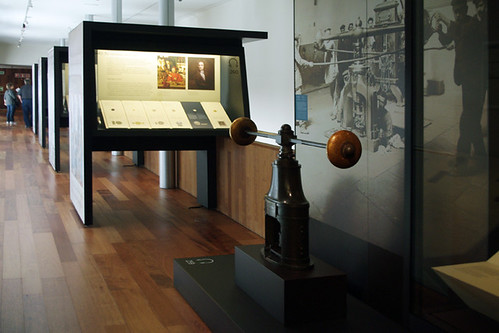
View of the National Archeological Museum’s exhibit on the mezzanine with a fly, or screw press in the foreground. After the visiting the Royal Mint’s museum, we took the metro to National Archeological Museum. Compared with the Royal Mint, this museum’s numismatic exhibition is quite a bit smaller in its breadth but just as interesting, occupying 14 displays on one section of the mezzanine floor. 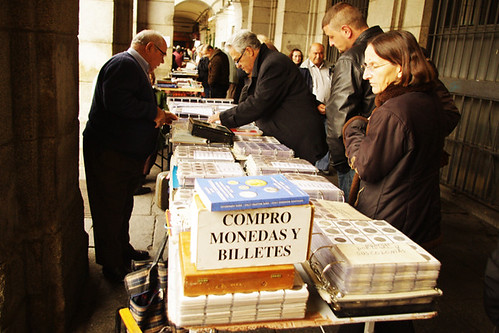
One of the many sellers at the weekly Sunday flea market under the arcades of the Plaza Mayor. The sign says “I buy coins and banknotes." On Sundays from 9 am to 3 pm, there is an outdoor flea market of both numismatic and philatelic items held under the arcades of the Plaza Mayor – a well-known Madrid tourist spot which has an infamous past. The Plaza Mayor is an enclosed rectangular square with nine entrances that was originally built in 1619 and last reconstructed in 1790 after a series of fires. There are three stories with residential units having over 230 balconies facing the plaza above arcades that surround it. Over the centuries the plaza has been graced with the royal court, bullfights, and the Spanish Inquisition, where suspected heretics were tried and quickly executed. Today, as it is every Sunday morning, rain or shine, many of Madrid’s coin and stamp buyers and sellers converge on the Plaza Mayor’s arcades for the weekly flea market. This is nothing fancy. Some sellers operate using a simple card table and a few notebooks filed with coins; other have more elaborate setups. Most of the items are Spanish coins, banknotes, postcards, bottle caps, and stamps, but on any given day, some dealers will have non-Spanish items, even U.S. mint and proof sets. It gives a good idea what some Spaniards collect. Like most flea markets, some haggling is encouraged. Next: Oxford and the Ashmolean Museum Wayne Homren, Editor The Numismatic Bibliomania Society is a non-profit organization promoting numismatic literature. See our web site at coinbooks.org. To submit items for publication in The E-Sylum, write to the Editor at this address: whomren@gmail.com To subscribe go to: https://my.binhost.com/lists/listinfo/esylum All Rights Reserved. NBS Home Page Contact the NBS webmaster 
|